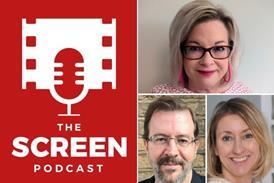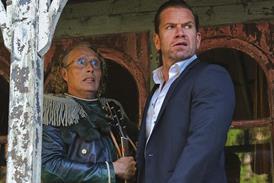
When Moana 2 sailed into industry record books with its $386m worldwide opening weekend, it proved once again the enormous global pulling power of animated features. But the Disney sequel’s impressive debut came near the end of a year that has often seemed like the worst as well as the best of times for the US animation industry.
At the box office, animation has been forging ahead. The family film category, including animated and live-action releases, “was hit harder during the pandemic than other genres”, says David A Gross of industry newsletter FranchiseRe. “But starting with The Super Mario Bros Movie in the spring of ’23, it took off, and since then it’s been much healthier.” (Universal and Illumination’s animated release proved a surprisingly big hit, taking $1.36bn worldwide.)
Even before Moana 2, three other animated releases, all of them sequels, ranked high in 2024’s worldwide box-office chart: Disney/Pixar’s Inside Out 2 topped the table with nearly $1.7bn, followed by Universal/Illumination’s Despicable Me 4 in third place ($969m) and Universal/DreamWorks Animation’s Kung Fu Panda 4 in sixth ($548m). The highest-ranking non-sequel animated feature was Universal/DreamWorks’ The Wild Robot, currently in 14th place at $322m.
According to online database The Numbers, digital animation had (as of early December) a North American market share of 23.8% in 2024, compared to 19% in 2023 and a pre-pandemic high of 20.1% in 2016. And according to FranchiseRe, family films as a whole are on course for a total worldwide gross of $6.85bn for 2024, up from $4.22bn for 2023 and the highest tally since 2019’s $8.95bn.
In addition to the impressive grosses, there are other reasons why studios favour animated features, especially those that are sequels or franchise-based: they have wide and built-in appeal to all four audience quadrants; they have strong box-office legs and play excellently in streaming and other home markets; they generally require fewer residual payments to creatives; and they offer huge merchandising possibilities.
Behind the box-office numbers, however, the animation industry has been experiencing some seriously choppy waters. Impacted, like the rest of the Hollywood ecosystem, by the contraction that has followed the streaming wars and 2023’s actors and writers strikes, a number of major animation players have implemented cutbacks over the past year. DreamWorks Animation and Netflix’s feature animation division both made significant workforce reductions late in 2023; the UK’s Aardman Animations recently reduced its staff by just under 5%, partly through voluntary redundancy; and Pixar laid off 175 workers ahead of this summer’s release of Inside Out 2, reducing its workforce by 14%.
Pixar told employees the cuts went with a move away from creating streaming content for Disney+ to refocus on features. In interviews around the launch of Inside Out 2, meanwhile, Pixar’s chief creative officer Pete Docter spoke about the company, whose features have long been revered in the industry for their originality, moving “to balance our output with more sequels” and deliver “the best possible and most relatable films”.
The widespread cutting of jobs “bespeaks the lack of vision in a lot of the corporate strategy”, suggests Tom Sito, the Hollywood animation veteran who is now a professor at the University of Southern California’s School of Cinematic Arts. Many animation executives, Sito suggests, “are trying to figure out how to control costs, and to them it always comes down to cutting staff”. (None of the studios contacted by Screen International made executives available for comment.)
Talent drift
The cuts also reflect the studios’ growing practice of outsourcing work away from California, where animation does not currently qualify for the state’s tax incentive programme, to facilities in Canada, Australia and parts of Europe.
More studios, say insiders, are now making animated features on the pipeline model used for animated TV series, where development and design work is typically done in Hollywood, but the actual animation elsewhere. (Moana 2 — originally developed as a streaming series — is reportedly the first feature on which the animation was split between Los Angeles and Disney’s three-year-old facility in Vancouver.)
“What we are seeing is a desire to take more of the work away from California, where it’s not incentivised, and move it to states or regions, both in the US and outside, that provide government subsidies for the work,” says Steve Kaplan, business representative at the Animation Guild, the division of the IATSE film workers union that represents more than 6,000 animation artists, writers, technicians and production workers, most of them based in Los Angeles.
Outsourcing was one of the issues discussed during this autumn’s contract talks between the Animation Guild and the Alliance of Motion Picture and Television Producers. Though the discussions extended over several months, increasing tensions in the Hollywood industry, they eventually resulted in a tentative agreement. At press time, the terms of the agreement had yet to be made public or ratified by the guild’s membership.
“Unfortunately, they weren’t able to make much progress,” says Kaplan about whether the guild’s negotiators were able to secure protections against outsourcing in the contract talks. But he is hopeful a proposal from California governor Gavin Newsom to almost double the funding for the state’s production incentive could open a door for animation to be made eligible.
“We’re certainly vying to see if animation could be a part of that,” Kaplan says of the proposal.
AI advances
The use of artificial intelligence was another key issue in the guild’s contract talks and it remains a major concern for most of those working in the US animation industry. A recent report commissioned by the guild predicted that 21% of film, TV and animation jobs in the US will be “consolidated, replaced or eliminated” by AI by 2026. At a recent conference, former Disney studio head and DreamWorks co-founder Jeffrey Katzenberg suggested that while in his day a major animated feature “took 500 artists five years to make… I don’t think it will take 10% of that three years from now.”
Kaplan says that in its contract talks, the guild “laid a strong foundation for communication and addressing concerns in artificial intelligence. [But] we have to continue to monitor and watch how [it] makes its way into the industry. We haven’t seen it implemented at this point, but the tests we’ve seen show us the potential for it being incredibly disruptive.”
In the short term, the leading animation studios appear set to rely on the appeal of sequels and franchise entries at the worldwide box office. Big animated titles on the release calendar for 2025 include DreamWorks Animation’s The Bad Guys 2, Disney’s Zootopia 2 and Sony’s Spider-Man: Beyond The Spider-Verse, with Pixar’s Elio being the most notable original feature.
But relying on sequels while cutting back on the development of new stories and characters is a dangerous course, argue animation industry creatives. “I see a lot of executive cowardice and incompetence happening right now,” says Sito. “Everybody on the creative level loves to make these movies, but we need executives with vision who can take risks. A lot of executives right now are playing it safe. That’s why there are so many damn sequels.”















![[Clockwise from top left]: Paul Thomas Anderson, Chloe Zhao, Ryan Coogler, Park Chan-wook](https://d1nslcd7m2225b.cloudfront.net/Pictures/274x183/9/0/0/1467900_writerdirectors_192733.jpg)




![[Clockwise from top left]: Paul Thomas Anderson, Chloe Zhao, Ryan Coogler, Park Chan-wook](https://d1nslcd7m2225b.cloudfront.net/Pictures/100x67/9/0/0/1467900_writerdirectors_192733.jpg)



No comments yet